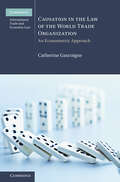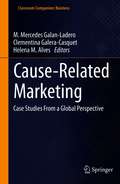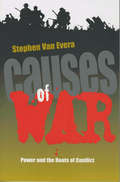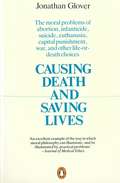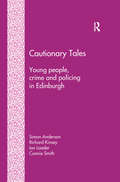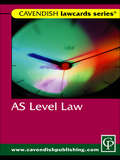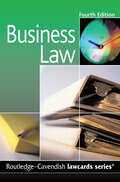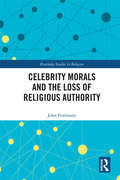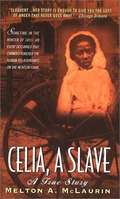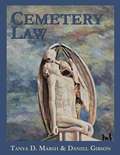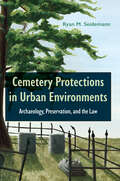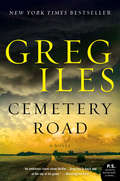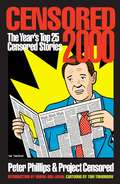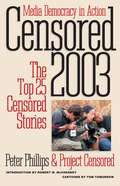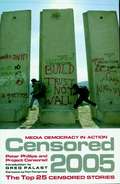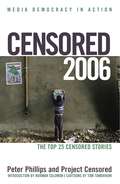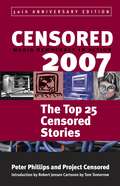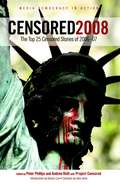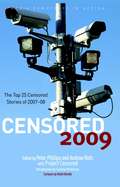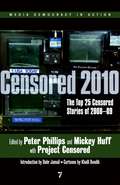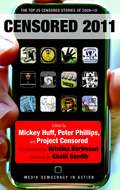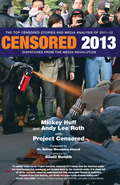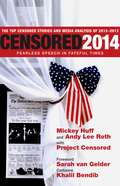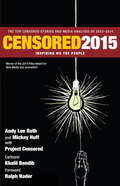- Table View
- List View
Causation in the Law of the World Trade Organization: An Econometric Approach (Cambridge International Trade and Economic Law)
by Catherine GascoigneCausation in the Law of the World Trade Organization: An Econometric Approach is for both scholars and practitioners of WTO law with an interest in the causal questions that WTO law raises. Assuming no prior knowledge of causal philosophy or statistical analysis, Dr Gascoigne discusses the problems in the current approach to causation in the WTO jurisprudence and proposes an alternative methodology that draws on causal philosophy and econometric analysis. The book demonstrates how this methodology could be harnessed to make causal determinations for the purpose of implementing trade remedies and to make out claims of serious prejudice. It also argues that the methodology could be helpful for assessing the impact of domestic legislation on policy objectives under the General Exceptions and the Technical Barriers to Trade Agreement as well as for calculating the amount of retaliation permissible under the Dispute Settlement Understanding.
Cause-Related Marketing: Case Studies From a Global Perspective (Classroom Companion: Business)
by M. Mercedes Galan-Ladero Helena M. Alves Clementina Galera-CasquetThis textbook uses a case study approach to present a variety of cause-related marketing campaigns that have been developed by companies, and NGOs. These innovative case studies help students understand how such campaigns affect for-profit and non-profit organizations, customers, and society in general. This book also offers numerous useful examples to understand the theory of cause-related marketing and how it can be applied in different countries and cultural contexts. Lecturers will find the teaching notes provided with each case useful for the classroom.
Causes and Consequences of Migrant Criminalization (Ius Gentium: Comparative Perspectives on Law and Justice #81)
by Neža Kogovšek ŠalamonThe book illustrates how the trend of associating migrants and refugees with criminality is on the rise. In political discourses and popular media alike, migrants and refugees are frequently portrayed as being dangerous, while cultures intent on welcoming newcomers are increasingly seen as being naïve, and providing assistance to migrants is more and more frequently subject to administrative or criminal penalties. At the same time, nondemocratic trends and practices that violate human rights and equality are gaining momentum in Europe, the US and Australia. Racism, xenophobia and anti-Islamism are simultaneously becoming more open and public; they are no longer restricted to clandestine platforms but are increasingly being mainstreamed into the political programs of parties that are entering both the EU parliaments and member state legislatures. Similar developments can be seen in the US and Australia. Such transformations in societies, governments, and institutions seem to reflect a growing amnesia regarding the lessons of the two World Wars of the 20th century, and the role that Europe, the US and Australia played in developing a post-war legal framework based on a shared, if imperfect, commitment to human rights. The book presents individual national analyses to reveal an emerging trend of “crimmigration” regardless of the peculiarities of national legislatures and internal political dynamics. By collecting original contributions from scholars based in and focused on each of these regions, it addresses above all the causes and impacts of the criminalization of migration in the early 21st century. It tackles the direct causes of these trends and encourages readers to rethink their broader political and socio-historic context. Importantly, the book does so by highlighting the ties between the criminalization of migration and equality, racism, and xenophobia. As the politics of migration become more perilous for political alliances like the EU as well for individual migrants, it is more important than ever to critically examine the cause and consequences of migrant criminalization. This collection does so from a variety of disciplinary perspectives and political traditions, seeking to overcome the distractions of charismatic politicians and the peculiar factions of national political systems, in order to reveal the underlying trends and disturbing patterns that are of interest to a broad, internationally-focused audience.
Causes of War: Power and the Roots of Conflict (Cornell Studies in Security Affairs)
by Stephen Van EveraWhat causes war? How can military conflicts best be prevented? A prominent political scientist here addresses these questions, offering ideas that will be widely debated. Stephen Van Evera frames five conditions that increase the risk of interstate war: false optimism about the likely outcome of a war, a first-strike advantage, fluctuation in the relative power of states, circumstances that allow nations to parlay one conquest into another, and circumstances that make conquest easy. According to Van Evera, all but one of these conditions-false optimism-rarely occur today, but policymakers often erroneously believe in their existence. He argues that these misperceptions are responsible for many modern wars, and explores both World Wars, the Korean War, and the 1967 Mideast War as test cases. Finally, he assesses the possibility of nuclear war by applying all five hypotheses to its potential onset. Van Evera's book demonstrates that ideas from the Realist paradigm can offer strong explanations for international conflict and valuable prescriptions for its control.
Causing Death and Saving Lives: The Moral Problems of Abortion, Infanticide, Suicide, Euthanasia, Capital Punishment, War and Other Life-or-death Choices
by Jonathan GloverThe moral problems of abortion, infanticide, suicide, euthanasia, capital punshiment, war and othe life-or-death choices.
Cautionary Tales: Young People, Crime and Policing in Edinburgh
by Connie Smith Simon Anderson Richard KinseyJuvenile crime makes headlines. It is the stock-in-trade of politicians and pundits. But young people are also the victims of crime. They too have demands to make of the police. Drawing upon survey and interview research with 11 to 15 year-olds in Edinburgh, this book examines how crime impacts upon young people’s everyday lives. It reveals that young people experience far more serious problems as victims and witnesses of crime, than they cause as offenders. It shows that they report little of their experiences of crime to the police, and are left to find their own ways of managing risk, such as telling cautionary tales about dangerous people and places. The study concludes by examining young people's relations with the police, suggesting they are over-controlled as suspects and under-protected as victims.
Cavendish: AS Level Lawcard (Lawcards)
by Routledge-CavendishCavendish Lawcards are complete, pocket-sized guides to key examinable areas of the law for both undergraduate and PGDL courses. Their concise text, user-friendly layout and compact format make Cavendish Lawcards the ideal revision aid for identifying, understanding, and committing to memory the salient points of each area of the law.
Cavendish: Business Lawcards (Lawcards)
by Routledge-CavendishCavendish lawcards are complete pocket sized guides to the key examinable areas of law. Their concise text, user-friendly layout and compact format makes them the ideal revision aid for identifying, understanding and memorizing the vital aspects of each area of law. Important features of the new edtion include: New four colour text design for easier navigation throughout each book Colour coded highlighting of cases and legislation Diagrams and flowcharts Bullet points of crucial information
Celebrity Morals and the Loss of Religious Authority (Routledge Studies in Religion)
by John PortmannThis book examines American popular culture to demonstrate that celebrities have superseded religious figures as moral authorities. As trust in religious institutions has waned over recent decades, the once frivolous entertainment fringe has become the moral center. Young people and voters increasingly take cues from actors and athletes. The book begins by offering a definition of celebrity and showing that the profile of celebrities has changed dramatically, particularly since the 1960s. They can now chart their own careers, manage their own personal lives and weigh in on pressing moral issues in a manner that hasn’t always been the case. This can be to the good, it is argued, for some counterintuitive reasons. Very few stars pretend to be moral exemplars, unlike the frequently hypocritical elites they have replaced. Others, however, are seemingly poorly qualified to speak on complex moral issues. In the end, it also turns out that who tells us how to feel about any moral issue counts at least as much as what they tell us. This is a fresh look at the impact of celebrity culture on contemporary morality and religious authority. As such, it will be of great use to academics working in religious studies and ethics, as well as popular culture and media studies.
Celia, A Slave
by Melton A. MclaurinIn 1850, fourteen-year-old Celia became the property of Robert Newsom, a prosperous and respected Missouri farmer. For the next five years, she was cruelly and repeatedly molested by her abusive master--and bore him two children in the process. But in 1855, driven to the limits of her endurance, Celia fought back. And at the tender age of eighteen, the desperate and frightened young black woman found herself on trial for Newsom's murder--the defendant in a landmark courtroom battle that threatened to undermine the very foundations of the South's most cherished institution. Based on court records, correspondences and newspaper accounts past and present, Celia, A Slave is a powerful masterwork of passion and scholarship--a stunning literary achievement that brilliantly illuminates one of the most extraordinary events in the long, dark history of slavery in America.
Cemetery Law: The Common Law of Burying Grounds in the United States
by Tanya D. Marsh Daniel GibsonConcerns about the cost and environmental consequences of the “traditional” American model of burial—embalming, casket, vault, single perpetual grave—are prompting the first significant challenges to American disposition practices since the Civil War. Burial itself is even being challenged—the popularity of cremation has exploded in recent decades and it will soon become the dominant practice. Americans eager to innovate in deathcare find that the law—still heavily rooted in 17th century English, Protestant practices and beliefs—is ill-equipped to adapt. Cemetery law in the United States has changed little in the past 200 years, but the challenges to our disposition practices are so widespread and significant that it will soon have no choice. It is unimaginable that we will start with a clean slate. Instead, the law will, as it always does in a common law system, slowly evolve from its current form. Before we can change the law, we must first understand it. This book is designed to help jumpstart that process by outlining the history, structure, and doctrines of the common law of burying grounds in the United States.
Cemetery Protections in Urban Environments: Archaeology, Preservation, and the Law
by Ryan M. SeidemannA history and practical analysis of legal protections for urban landscapes of grieving and cultural memory In this book, Ryan Seidemann brings together the areas of burial legislation, urban planning, history, biological anthropology, and archaeology to illuminate the role of the law in the protection and preservation of cemetery spaces. Providing a history and analysis of cemetery site protections in the United States, Seidemann explains current legal and law enforcement realities and discusses how to prevent future damage and development in urban burial grounds. Seidemann shows that while legal measures are put in place to honor the dead and uphold the maintenance of burial sites, these laws are unevenly enforced and can be ineffective, often failing to protect cemeteries important to people who do not have the power to fight developers. Offering case studies from his own work in Louisiana, Seidemann demonstrates that priorities of urban planning and private property are often emphasized at the expense of local communities. Cemetery Protections in Urban Environments illustrates the knowledge and specialization that both archaeology and the legal world contribute to the preservation of burial locations. This book provides a concise overview of the legal tools that exist and the tools that are needed to preserve such sites, useful for researchers and practitioners in a variety of fields.
Cemetery Road: A Novel
by Greg IlesSometimes the price of justice is a good man’s soul.The #1 New York Times bestselling author of the Natchez Burning trilogy returns with an electrifying tale of friendship, betrayal, and shattering secrets that threaten to destroy a small Mississippi town. <P><P>When Marshall McEwan left his Mississippi hometown at eighteen, he vowed never to return. The trauma that drove him away spurred him to become one of the most successful journalists in Washington, DC. But as the ascendancy of a chaotic administration lifts him from print fame to television stardom, Marshall discovers that his father is terminally ill, and he must return home to face the unfinished business of his past. <P><P>On arrival, he finds Bienville, Mississippi very much changed. His family’s 150-year-old newspaper is failing; and Jet Turner, the love of his youth, has married into the family of Max Matheson, one of a dozen powerful patriarchs who rule the town through the exclusive Bienville Poker Club. To Marshall’s surprise, the Poker Club has taken a town on the brink of extinction and offered it salvation, in the form of a billion-dollar Chinese paper mill. But on the verge of the deal being consummated, two murders rock Bienville to its core, threatening far more than the city’s economic future. <P><P>An experienced journalist, Marshall has seen firsthand how the corrosive power of money and politics can sabotage investigations. Joining forces with his former lover—who through her husband has access to the secrets of the Poker Club—Marshall begins digging for the truth behind those murders. But he and Jet soon discover that the soil of Mississippi is a minefield where explosive secrets can destroy far more than injustice. <P><P>The South is a land where everyone hides truths: of blood and children, of love and shame, of hate and murder—of damnation and redemption. The Poker Club’s secret reaches all the way to Washington, D.C., and could shake the foundations of the U.S. Senate. But by the time Marshall grasps the long-buried truth about his own history, he would give almost anything not to have to face it. <P><b>A New York Times Bestseller</b>
Censored 2000: The Year's Top 25 Censored Stories
by Peter Phillips Project Censored Mumia Abu-Jamal Tom TomorrowThe yearly volumes of Censored, in continuous publication since 1976 and since 1995 available through Seven Stories Press, is dedicated to the stories that ought to be top features on the nightly news, but that are missing because of media bias and self-censorship. The top stories are listed democratically in order of importance according to students, faculty, and a national panel of judges. Each of the top stories is presented at length, alongside updates from the investigative reporters who broke the stories.Beyond the Top 25 stories, additional chapters delve further into timely media topics: The Censored News and Media Analysis section provides annual updates on Junk Food News and News Abuse, Censored Déjà Vu, signs of hope in the alternative and news media, and the state of media bias and alternative coverage around the world. In the Truth Emergency section, scholars and journalists take a critical look at the US/NATO military-industrial-media empire. And in the Project Censored International section, the meaning of media democracy worldwide is explored in close association with Project Censored affiliates in universities and at media organizations all over the world.A perennial favorite of booksellers, teachers, and readers everywhere, Censored is one of the strongest life signs of our current collective desire to get the news we citizens need--despite what Big Media tells us.
Censored 2003: The Top 25 Censored Stories
by Robert W. Mcchesney Peter Phillips Project Censored Tom TomorrowThe yearly volumes of Censored, in continuous publication since 1976 and since 1995 available through Seven Stories Press, is dedicated to the stories that ought to be top features on the nightly news, but that are missing because of media bias and self-censorship. The top stories are listed democratically in order of importance according to students, faculty, and a national panel of judges. Each of the top stories is presented at length, alongside updates from the investigative reporters who broke the stories.
Censored 2005: The Top 25 Censored Stories
by Greg Palast Peter Phillips Project Censored Tom TomorrowThe yearly volumes of Censored, in continuous publication since 1976 and since 1995 available through Seven Stories Press, is dedicated to the stories that ought to be top features on the nightly news, but that are missing because of media bias and self-censorship. The top stories are listed democratically in order of importance according to students, faculty, and a national panel of judges. Each of the top stories is presented at length, alongside updates from the investigative reporters who broke the stories.
Censored 2006: The Top 25 Censored Stories
by Norman Solomon Peter Phillips Project Censored Tom TomorrowThe yearly volumes of Censored, in continuous publication since 1976 and since 1995 available through Seven Stories Press, is dedicated to the stories that ought to be top features on the nightly news, but that are missing because of media bias and self-censorship. The top stories are listed democratically in order of importance according to students, faculty, and a national panel of judges. Each of the top stories is presented at length, alongside updates from the investigative reporters who broke the stories.
Censored 2007: The Top 25 Censored Stories
by Peter Phillips Project Censored Tom Tomorrow Robert JensenThe yearly volumes of Censored, in continuous publication since 1976 and since 1995 available through Seven Stories Press, is dedicated to the stories that ought to be top features on the nightly news, but that are missing because of media bias and self-censorship. The top stories are listed democratically in order of importance according to students, faculty, and a national panel of judges. Each of the top stories is presented at length, alongside updates from the investigative reporters who broke the stories.
Censored 2008: The Top 25 Censored Stories of 2006-07
by Dennis Loo Peter Phillips Project Censored John Jonik Andrew RothThe yearly volumes of Censored, in continuous publication since 1976 and since 1995 available through Seven Stories Press, is dedicated to the stories that ought to be top features on the nightly news, but that are missing because of media bias and self-censorship. The top stories are listed democratically in order of importance according to students, faculty, and a national panel of judges. Each of the top stories is presented at length, alongside updates from the investigative reporters who broke the stories.
Censored 2009: The Top 25 Censored Stories of 2007-08
by Peter Phillips Khalil Bendib Project Censored Andrew Roth Cynthia MckinneyThe yearly volumes of Censored, in continuous publication since 1976 and since 1995 available through Seven Stories Press, is dedicated to the stories that ought to be top features on the nightly news, but that are missing because of media bias and self-censorship. The top stories are listed democratically in order of importance according to students, faculty, and a national panel of judges. Each of the top stories is presented at length, alongside updates from the investigative reporters who broke the stories.
Censored 2010: The Top 25 Censored Stories of 2008-09
by Peter Phillips Dahr Jamail Khalil Bendib Project Censored Mickey HuffThe yearly volumes of Censored, in continuous publication since 1976 and since 1995 available through Seven Stories Press, is dedicated to the stories that ought to be top features on the nightly news, but that are missing because of media bias and self-censorship. The top stories are listed democratically in order of importance according to students, faculty, and a national panel of judges. Each of the top stories is presented at length, alongside updates from the investigative reporters who broke the stories.
Censored 2011: The Top 25 Censored Stories of 2009 - 10
by Peter Phillips Kristina Borjesson Khalil Bendib Project Censored Mickey HuffThe yearly volumes of Censored, in continuous publication since 1976 and since 1995 available through Seven Stories Press, is dedicated to the stories that ought to be top features on the nightly news, but that are missing because of media bias and self-censorship. The top stories are listed democratically in order of importance according to students, faculty, and a national panel of judges. Each of the top stories is presented at length, alongside updates from the investigative reporters who broke the stories.
Censored 2013: The Top Censored Stories and Media Analysis of 2011-2012
by Khalil Bendib Project Censored Mickey HuffEvery year since 1976, Project Censored, our nation's oldest news-monitoring group--a university-wide project at Sonoma State University founded by Carl Jensen, directed for many years by Peter Phillips, and now under the leadership of Mickey Huff--has produced a Top-25 list of underreported news stories and a book, Censored, dedicated to the stories that ought to be top features on the nightly news, but that are missing because of media bias and self-censorship.Seven Stories Press has been publishing this yearbook since 1994, featuring the top stories listed democratically in order of importance according to students, faculty, and a national panel of judges. Each of the top stories is presented at length, alongside updates from the investigative reporters who broke the stories.Beyond the Top-25 stories, additional chapters delve further into timely media topics: The Censored News and Media Analysis section provides annual updates on Junk Food News and News Abuse, Censored Deja Vu, signs of hope in the alternative and news media, and the state of media bias and alternative coverage around the world. In the Truth Emergency section, scholars and journalists take a critical look at the US/NATO military-industrial-media empire. And in the Project Censored International section, the meaning of media democracy worldwide is explored in close association with Project Censored affiliates in universities and at media organizations all over the world.A perennial favorite of booksellers, teachers, and readers everywhere, Censored is one of the strongest life signs of our current collective desire to get the news we citizens need--despite what Big Media tells us.
Censored 2014: Fearless Speech in Fateful Times; The Top Censored Stories and Media Analysis of 2012-13
by Khalil Bendib Project Censored Mickey Huff Sarah Van Gelder Andy Lee RothEvery year since 1976, Project Censored, our nation's oldest news-monitoring group--a university-wide project at Sonoma State University founded by Carl Jensen, directed for many years by Peter Phillips, and now under the leadership of Mickey Huff--has produced a Top-25 list of underreported news stories and a book, Censored, dedicated to the stories that ought to be top features on the nightly news, but that are missing because of media bias and self-censorship. Seven Stories Press has been publishing this yearbook since 1994, featuring the top stories listed democratically in order of importance according to an international panel of judges. Beyond the Top-25 stories, additional chapters delve further into timely media topics: The Censored News and Media Analysis section provides annual updates on Junk Food News and News Abuse, Censored Deja Vu, signs of hope in the alternative and news media, and the state of media bias and alternative coveragearound the world. In the Truth Emergency section, scholars and journalists take a critical look at the US/NATO military-industrial-media empire. And in the Project Censored International section, the meaning of media democracy worldwide is explored in close association with Project Censored affiliates in universities and at media organizations all over the world.A perennial favorite of booksellers, teachers, and readers everywhere, Censored is one of the strongest lifesigns of our current collective desire to get the news we citizens need--despite what Big Media tells us.
Censored 2015
by Ralph Nader Khalil Bendib Project Censored Mickey Huff Andy Lee RothEvery year since 1976, Project Censored, our nation's oldest news-monitoring group--a university-wide project at Sonoma State University founded by Carl Jensen, directed for many years by Peter Phillips, and now under the leadership of Mickey Huff--has produced a Top-25 list of underreported news stories and a book, Censored, dedicated to the stories that ought to be top features on the nightly news, but that are missing because of media bias and self-censorship.A perennial favorite of booksellers, teachers, and readers everywhere, Censored is one of the strongest life-signs of our current collective desire to get the news we citizens need--despite what Big Media tells us.From the Trade Paperback edition.x havens. . . . And so much more that didn't make the front page (or even back page). Informative and timely, appalling and sometimes uplifting, Censored alerts readers to the stories that were quashed in favor of media bias, celebrity scandals, and self-censorship, in hopes that we the people, armed with knowledge, put our bodies upon the gears--before it's too late.From the Trade Paperback edition.
